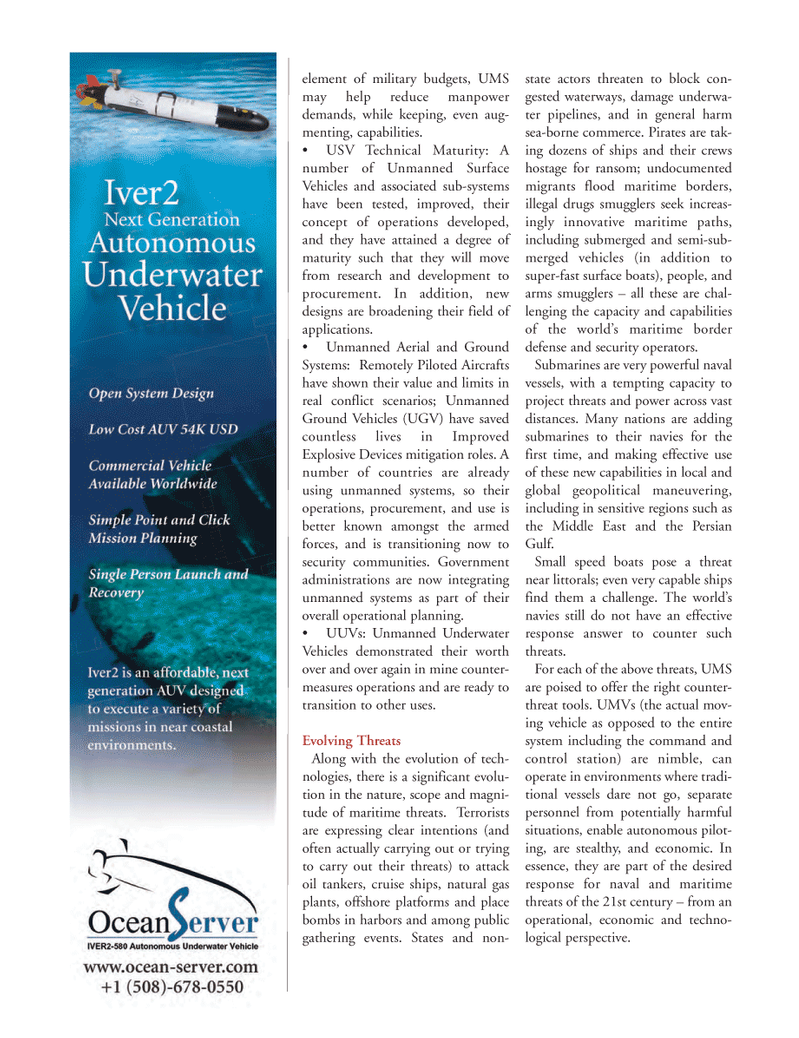
Page 26: of Marine Technology Magazine (October 2011)
Ocean Engineering & Design
Read this page in Pdf, Flash or Html5 edition of October 2011 Marine Technology Magazine
element of military budgets, UMS may help reduce manpower demands, while keeping, even aug- menting, capabilities. USV Technical Maturity: A number of Unmanned Surface Vehicles and associated sub-systems have been tested, improved, their concept of operations developed, and they have attained a degree of maturity such that they will move from research and development to procurement. In addition, new designs are broadening their field of applications.Unmanned Aerial and Ground Systems: Remotely Piloted Aircrafts have shown their value and limits in real conflict scenarios; Unmanned Ground Vehicles (UGV) have saved countless lives in Improved Explosive Devices mitigation roles. A number of countries are already using unmanned systems, so theiroperations, procurement, and use is better known amongst the armed forces, and is transitioning now to security communities. Government administrations are now integrating unmanned systems as part of their overall operational planning. UUVs: Unmanned Underwater Vehicles demonstrated their worth over and over again in mine counter- measures operations and are ready to transition to other uses.Evolving Threats Along with the evolution of tech- nologies, there is a significant evolu- tion in the nature, scope and magni- tude of maritime threats. Terrorists are expressing clear intentions (and often actually carrying out or trying to carry out their threats) to attack oil tankers, cruise ships, natural gas plants, offshore platforms and place bombs in harbors and among publicgathering events. States and non- state actors threaten to block con- gested waterways, damage underwa- ter pipelines, and in general harmsea-borne commerce. Pirates are tak- ing dozens of ships and their crews hostage for ransom; undocumentedmigrants flood maritime borders, illegal drugs smugglers seek increas- ingly innovative maritime paths, including submerged and semi-sub-merged vehicles (in addition to super-fast surface boats), people, and arms smugglers ? all these are chal- lenging the capacity and capabilitiesof the world?s maritime border defense and security operators.Submarines are very powerful naval vessels, with a tempting capacity to project threats and power across vast distances. Many nations are adding submarines to their navies for thefirst time, and making effective use of these new capabilities in local and global geopolitical maneuvering, including in sensitive regions such as the Middle East and the Persian Gulf. Small speed boats pose a threat near littorals; even very capable ships find them a challenge. The world?s navies still do not have an effective response answer to counter such threats. For each of the above threats, UMS are poised to offer the right counter- threat tools. UMVs (the actual mov- ing vehicle as opposed to the entire system including the command andcontrol station) are nimble, can operate in environments where tradi- tional vessels dare not go, separate personnel from potentially harmful situations, enable autonomous pilot-ing, are stealthy, and economic. In essence, they are part of the desired response for naval and maritime threats of the 21st century ? from an operational, economic and techno-logical perspective. MTR#8 (18-33):MTR Layouts 10/10/2011 2:08 PM Page 26

 25
25

 27
27
